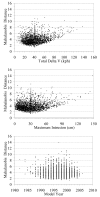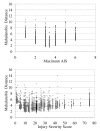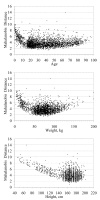A population-based comparison of CIREN and NASS cases using similarity scoring
- PMID: 18184504
- PMCID: PMC3217509
A population-based comparison of CIREN and NASS cases using similarity scoring
Abstract
The Crash Injury Research and Engineering Network (CIREN) provides significant details on injuries, and data on patient outcomes that is unavailable in the National Automotive Sampling System (NASS). However, CIREN cases are selected from specific Level I trauma centers with different inclusion criteria than those used for NASS, and the assertion that a given case is similar to the population of NASS cases is often made qualitatively. A robust, quantitative method is needed to compare CIREN to weighted NASS populations. This would greatly improve the usefulness and applicability of research conducted with data from the CIREN database. Our objective is to outline and demonstrate the utility of such a system to compare CIREN and NASS cases. This study applies the Mahalanobis distance metric methodology to determine similarity between CIREN and NASS/CDS cases. The Mahalanobis distance method is a multivariate technique for population comparison. Independent variables considered were total delta V, age, weight, height, maximum AIS, ISS, model year, gender, maximum intrusion, number of lower and upper extremity injuries, and number of head and chest injuries. The technique provides a unit-independent quantitative score which can be used to identify similarity of CIREN and NASS cases. Weighted NASS data and CIREN data were obtained for the years 2001-2005. NASS cases with Maximum AIS 3 resulted in a subset of 1,869 NASS cases, and 2,819 CIREN cases.
Figures











Similar articles
-
Appropriate analysis of CIREN data: using NASS-CDS to reduce bias in estimation of injury risk factors in passenger vehicle crashes.Accid Anal Prev. 2010 Mar;42(2):530-9. doi: 10.1016/j.aap.2009.09.019. Epub 2009 Oct 23. Accid Anal Prev. 2010. PMID: 20159077
-
Comparison of distributions of key predictor variables in CIREN and NASS-CDS cases meeting CIREN inclusion criteria.Traffic Inj Prev. 2009 Oct;10(5):451-7. doi: 10.1080/15389580903081065. Traffic Inj Prev. 2009. PMID: 19746309
-
Odontoid fracture in motor vehicle environments.Accid Anal Prev. 2005 May;37(3):505-14. doi: 10.1016/j.aap.2005.01.002. Accid Anal Prev. 2005. PMID: 15784204
-
Changes in injury patterns in frontal crashes: injuries to drivers of vehicles model year 1993-1997 vs. Drivers of vehicles 1998-2002 - an analysis of NASS/CDC data.Annu Proc Assoc Adv Automot Med. 2003;47:84. Annu Proc Assoc Adv Automot Med. 2003. PMID: 12941217 Free PMC article. Review. No abstract available.
-
Performance of advanced air bags based on data William Lehman Injury Research Center and new NASS PSUs.Annu Proc Assoc Adv Automot Med. 2003;47:99-101. Annu Proc Assoc Adv Automot Med. 2003. PMID: 12941219 Free PMC article. Review.
Cited by
-
Crash characteristics and injury patterns of restrained front seat occupants in far-side impacts.Traffic Inj Prev. 2014;15 Suppl 1(0 1):S27-34. doi: 10.1080/15389588.2014.935771. Traffic Inj Prev. 2014. PMID: 25307394 Free PMC article.
-
Comparison of AIS 1990 update 98 versus AIS 2005 for describing PMHS injuries in lateral and oblique sled tests.Ann Adv Automot Med. 2013;57:197-208. Ann Adv Automot Med. 2013. PMID: 24406958 Free PMC article.
-
Demographics, Velocity Distributions, and Impact Type as Predictors of AIS 4+ Head Injuries in Motor Vehicle Crashes.Ann Adv Automot Med. 2011;55:267-80. Ann Adv Automot Med. 2011. PMID: 22105402 Free PMC article.
-
Aging is not a risk factor for femoral and tibial fractures in motor vehicle crashes.Ann Adv Automot Med. 2008 Oct;52:227-34. Ann Adv Automot Med. 2008. PMID: 19026239 Free PMC article.
References
-
- Acierno S, Kaufman R, et al. Vehicle mismatch: injury patterns and severity. Accid Anal Prev. 2004;36(5):761–72. - PubMed
-
- Assal M, Huber P, et al. Are drivers more likely to injure their right or left foot in a frontal car crash: a crash and biomechanical investigation. Annu Proc Assoc Adv Automot Med. 2002;46:273–88. - PubMed
-
- Benson E, Conroy C, et al. Calcaneal fractures in occupants involved in severe frontal motor vehicle crashes. Accid Anal Prev 2007 - PubMed
-
- Brookes C, Wang S, et al. Maxillofacial injuries in North American vehicle crashes. Eur J Emerg Med. 2003;10(1):30–4. - PubMed
Publication types
MeSH terms
LinkOut - more resources
Full Text Sources
Medical
